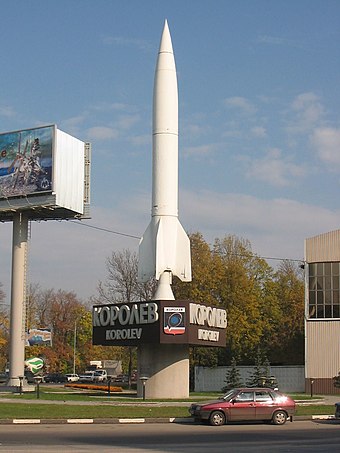R-2 (missile)
| R-2 | |
|---|---|
 R-2 missile at Korolev City of Moscow region | |
| Type | Theatre ballistic missile Short-range ballistic missile |
| Place of origin | USSR |
| Service history | |
| In service | 27 November 1951 – 1962 |
| Used by | Soviet Union |
| Production history | |
| Manufacturer | Yuzhmash and OKB-1 |
| Specifications | |
| Mass | 19,632 kg |
| Length | 17.70 m |
| Diameter | 1.65 m |
| Engine | RD-101 |
| Wingspan | 3.60 m |
| Propellant | LOX / Alcohol |
Operational range | 576 km (358 mi) |
| Maximum speed | 2175 m/s |
| Accuracy | 8 km[1] |
The R-2 Short-range ballistic missile (NATO reporting name SS-2 Sibling, GRAU index 8Zh38) was developed based on the R-1 design. This was an improved version of the German V-2 rocket manufactured by the Soviet Union.
Description
The R-1 was quickly followed by an evolutionary improvement, the R-2 (SS-2), which had a longer range and at least four major differences in design. The weight was increased by 50%, but the range was more than doubled, to 576 km (358 mi).[1] R-2 had the following major differences from the R-1's (and hence from the V-2's) design:[2]
- The warhead separated from the rocket prior to atmospheric reentry, eliminating the hull strength problem, one of the V-2/R-1's biggest weaknesses.
- The propellant tank became the main load-bearing structure for the rocket, in contrast to the R-1's load-bearing hull. This reduced the overall weight of the spaceframe.
- The control module was moved from above the propellant tank to below the LOx tank. This made pre-launch preparations easier. As the control module was now placed directly over the engine, vibrations were reduced by using steel instead of aluminium for the tailcone.
- Radio command guidance was introduced to improve accuracy, giving the R-2 accuracy comparable to the R-1, in spite of its doubled range.
The first test flight of the R-2 took place in September 1949, and it was accepted for service in November 1951, actually entering service in large numbers around 1953. A grand total of 1,545 R-1 and R-2 missiles were produced.
The R-2 missile was the last Soviet missile based on German designs. While German support helped in establishing production of the R-1 and enabling a base for further developments, Soviet missiles after the R-2 would be based on original designs by the OKB-1 group.[3]
The R-2A geophysical rocket was developed for vertical sounding flights.[4] Initial launch was on 16 May 1967.[4] It carried dogs, a rabbit and various high-altitude physics experiments in its nose cone.[5] Some of the animals suffered injuries caused by the 8g forces encountered through re-entry.[5] Two pods performed atmospheric analysis and were ejected from the missile's side to avoid contamination by engine exhaust.
The R-2 design was exported to China, where it was built as the Dongfeng 1.
Operators
See also
References
- ^ a b Podvig, Pavel, ed. (2004). Russian Strategic Nuclear Forces. MIT Press. p. 119. ISBN 9780262661812.
- ^ Khishchenko, Yu. M. (2000). Первые шаги отечественного ракетостроения учебное пособие по курсу "введение в авиационную и космическую технику" [The first steps of domestic rocket science: A manual on the course "Introduction to Aviation and Space Technology"] (in Russian). Chelyabinsk: SUSU. Archived from the original on 2020-04-19. Retrieved 2020-04-19.
- ^ Siddiqi, Asif (2000). Challenge to Apollo : the Soviet Union and the space race, 1945-1974 (PDF). Washington, D.C: National Aeronautics and Space Administration, NASA History Div. pp. 83–84. Retrieved 25 July 2022.
- ^ a b Harvey, Brian; Zakutnyaya, Olga (2011). Russian Space Probes: Scientific Discoveries and Future Missions. Springer-Praxis. p. 16. ISBN 9781441981493.
- ^ a b Harvey, Brian; Zakutnyaya, Olga (2011). Russian Space Probes: Scientific Discoveries and Future Missions. Springer-Praxis. pp. 22–23. ISBN 9781441981493.
